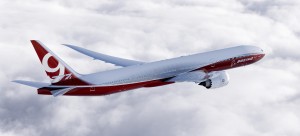
Boeing launched its new 777X at the November 2013 Dubai Airshow. Production of the aircraft is scheduled to begin in 2017 and first delivery is targeted for 2020.
Boeing’s participation at the November 2013 Dubai Airshow was marked by the launch of the 777X—the world’s largest twin-engine jetliner—and the announcement of historic orders and new strategic agreements signed with key partners in the Middle East and around the world.
Boeing chairman, president and chief executive officer Jim McNerney launched the 777X with 259 orders and commitments worth more than $95-billion at list prices, placing the 777X as the largest product launch in commercial jetliner history by value.
Key innovations in the 777X are an all-new composite wing based on the innovative wing developed for the 787 Dreamliner, aerodynamic advances such as a hybrid laminar flow control vertical tail and natural laminar flow nacelles and all-new GE9X engines developed by GE Aviation.
In addition to unprecedented fuel efficiency and environmental responsibility, these new technologies will help the 777X deliver 10 per cent lower operating economics than the competition.
The 777X’s efficiency directly links to exceptional environmental performance. Carbon dioxide (CO2) is produced as fuel is consumed. This means the reductions in fuel use will result in equivalent cuts in carbon dioxide emissions.
Two models comprise the 777X family—the 777-8X, with approximately 350 seats and a range capability of more than 17,223 kilometres; and the 777-9X, with approximately 400 seats and a range of more than 15,186 kilometres.
The 777-8X competes directly with the Airbus A350-1000 while the 777-9X is in a class by itself.
At 71 metres, the 777X composite wing has a longer span than today’s 777-300ER. Its folding, raked wingtip delivers greater efficiency, significant fuel savings and complete airport gate capability. In addition, it allows access to the entire range of gates currently accessibly by the 777-300ER.
Adding 787 technologies in the flight deck, flight controls and other systems is just the beginning. The 777X implements 787 technologies where they add value to Boeing customers and increase commonality across Boeing’s twin-aisle product family.
Boeing is exploring a number of innovations that will advance the passenger experience. For example, the company will reposition and resize windows to provide more interior ambient light and provide passengers with better views outside the cabin.
A new interior architecture will make the 777X cabin even more spacious, leveraging the airplane’s cross-section—the widest in its class.
The 777X is targeted for first delivery in 2020.





